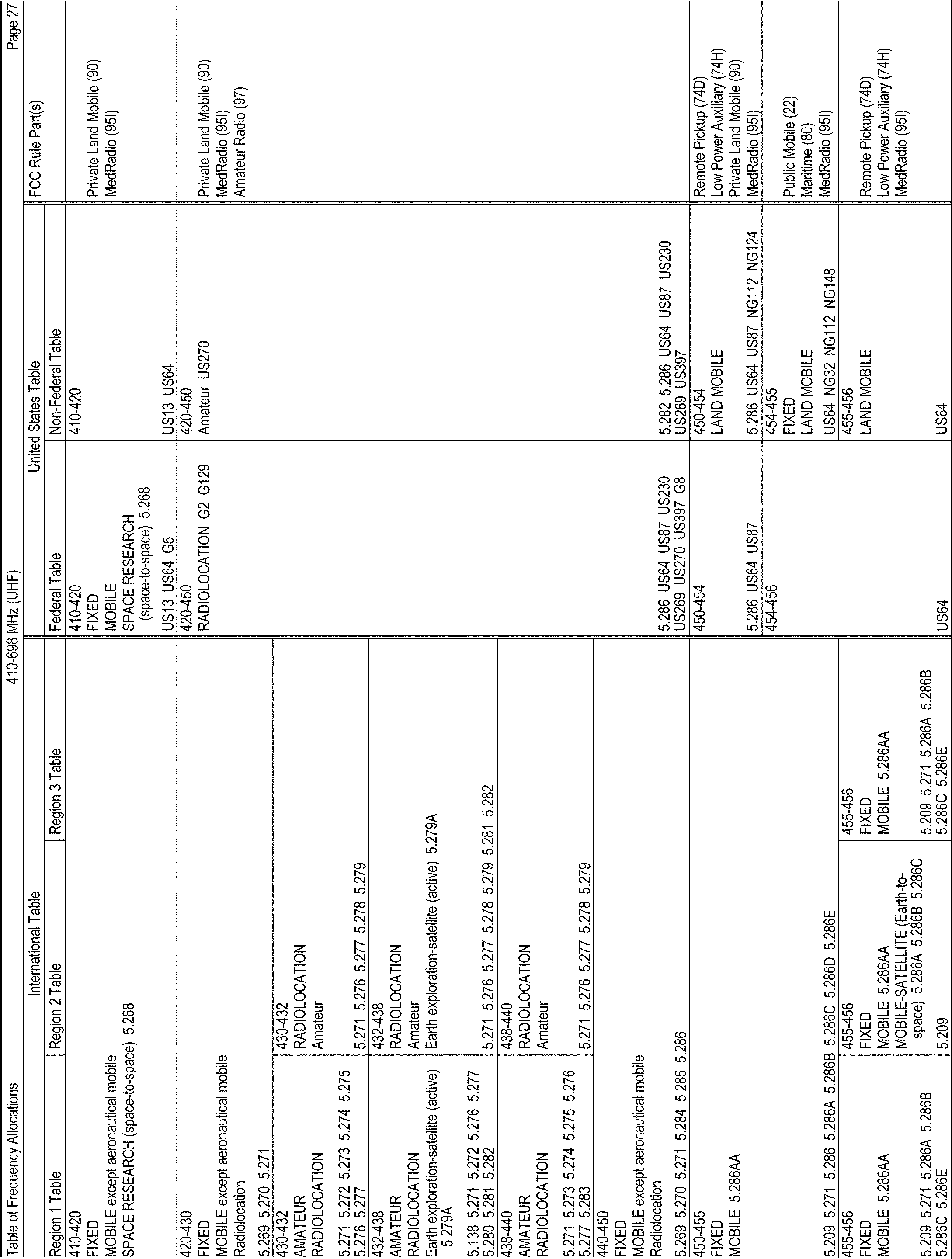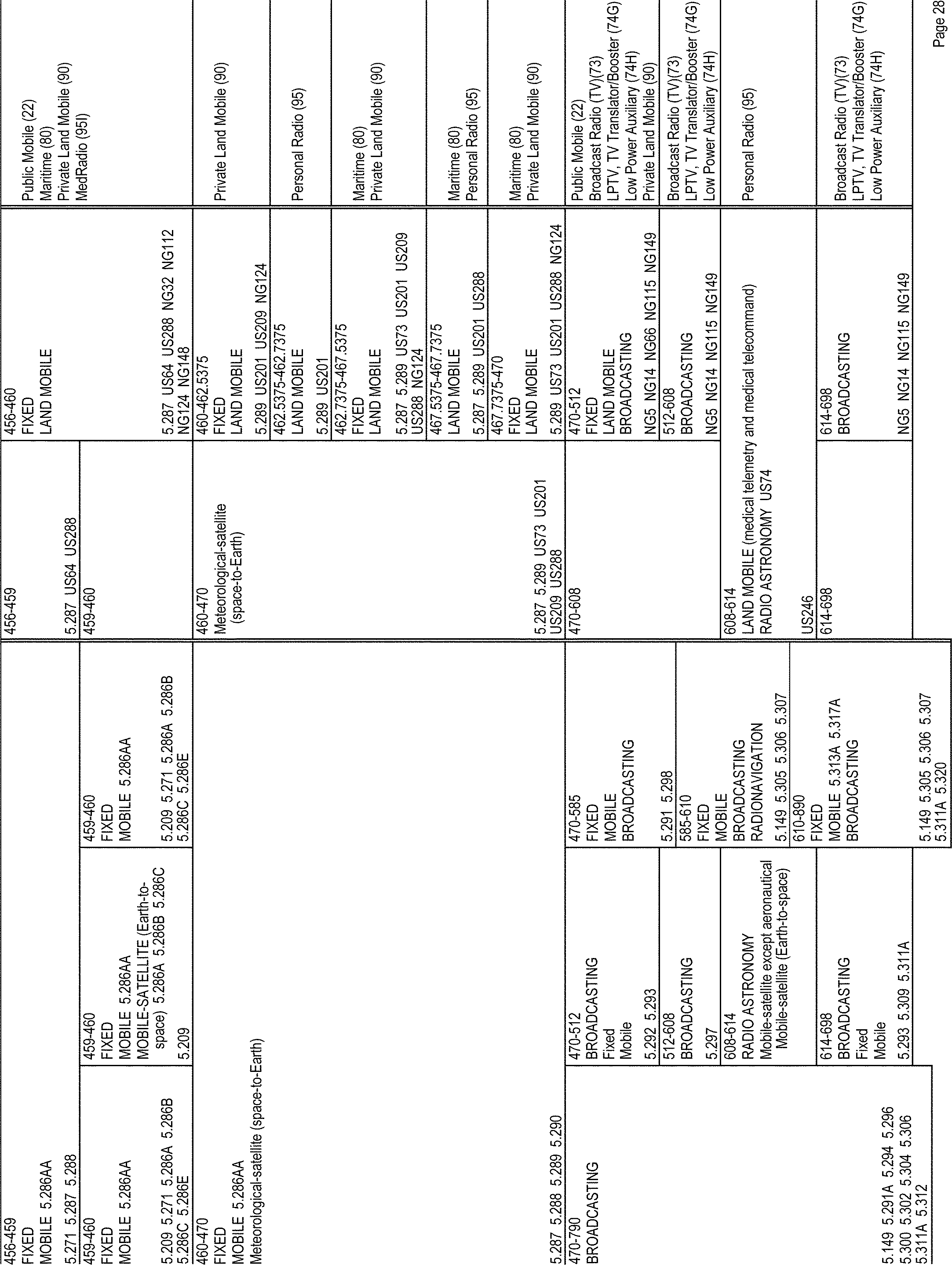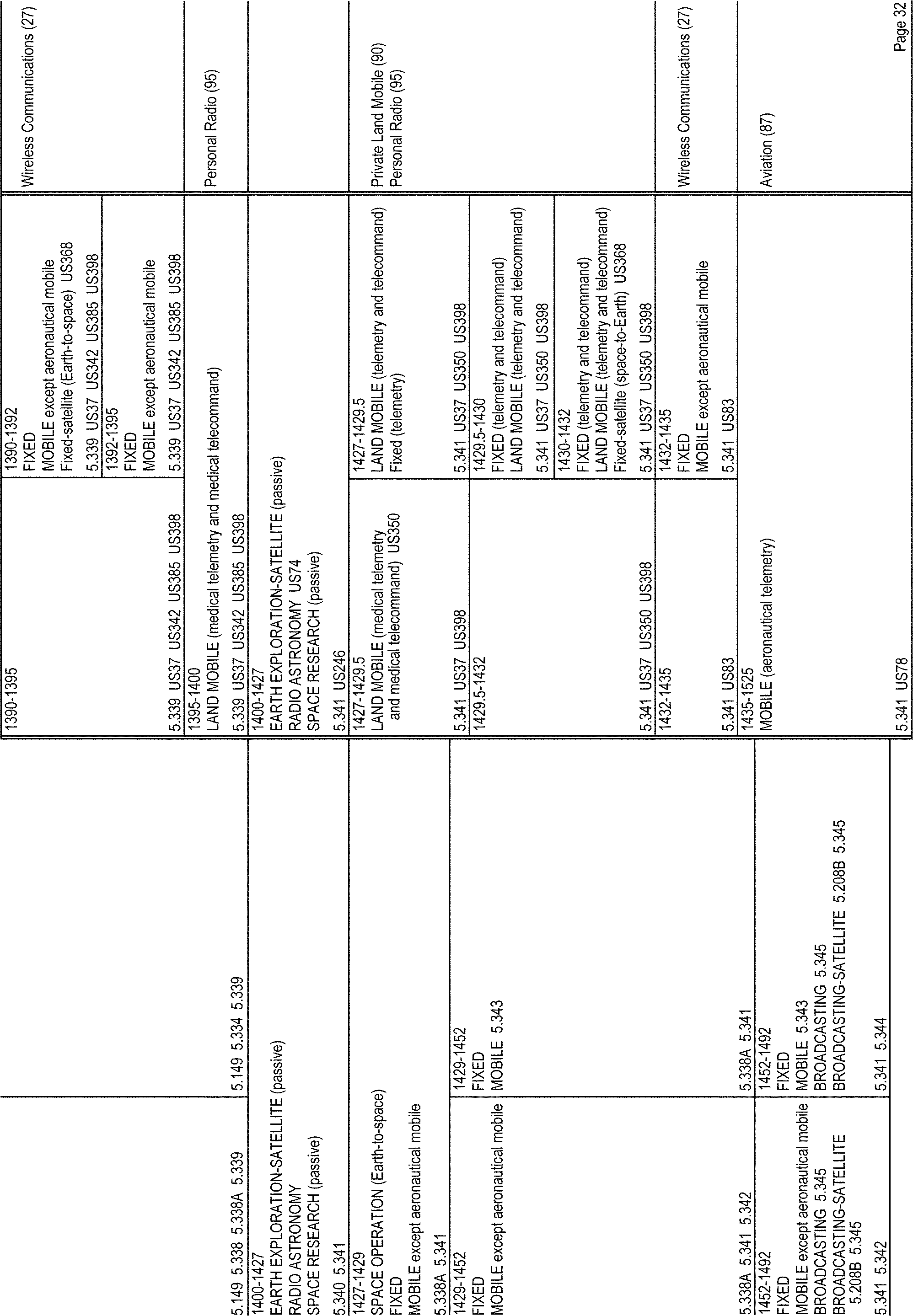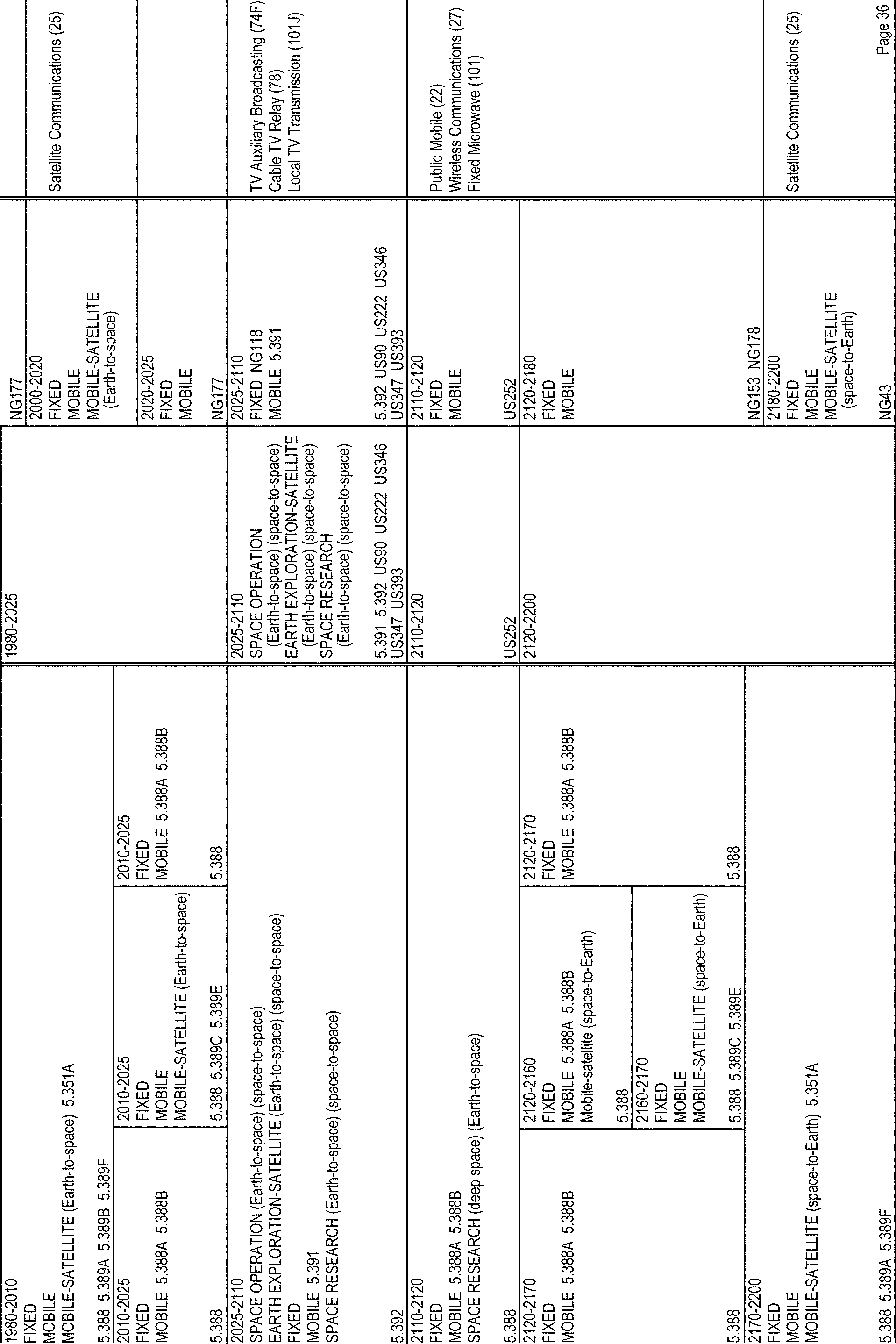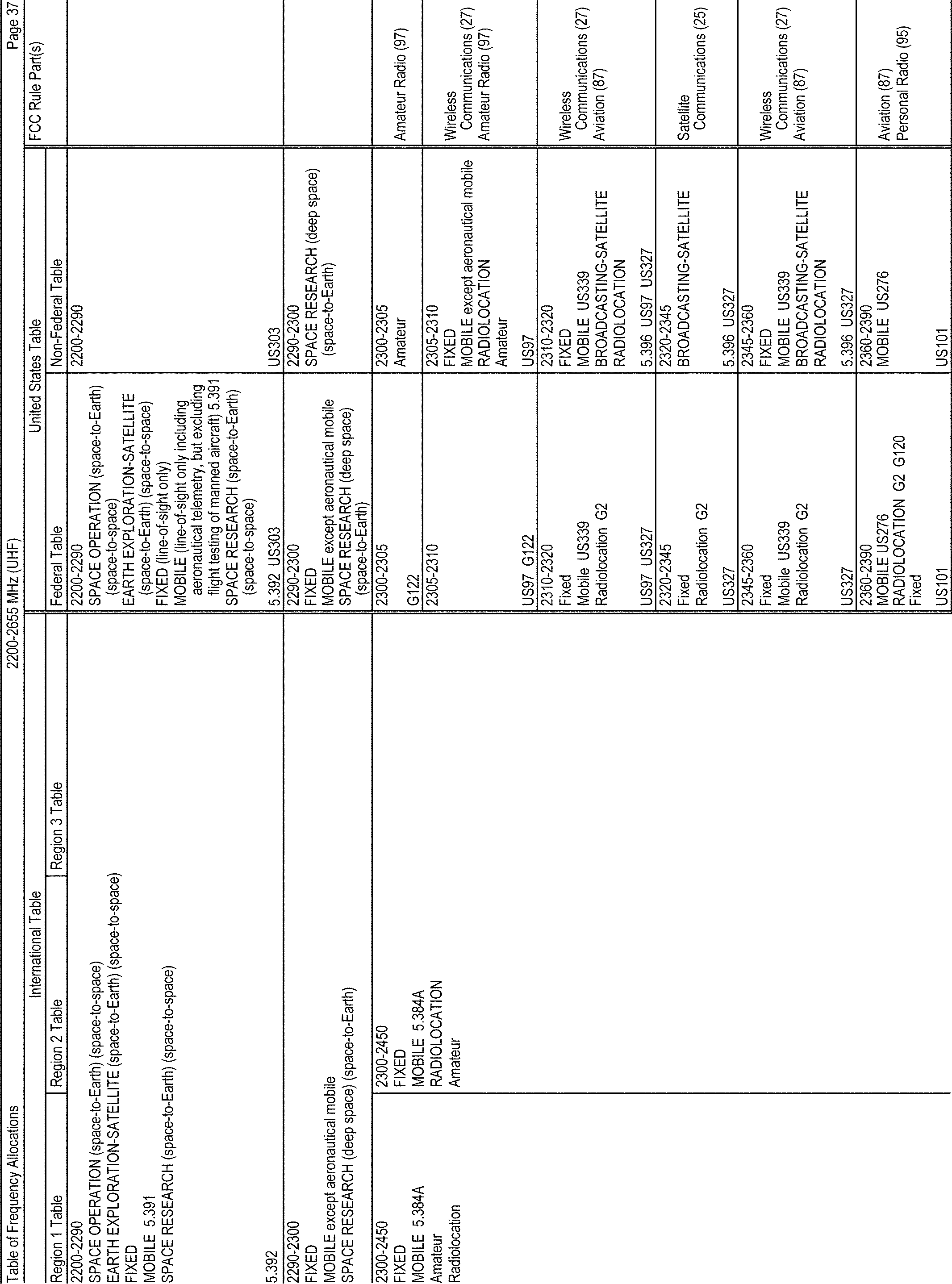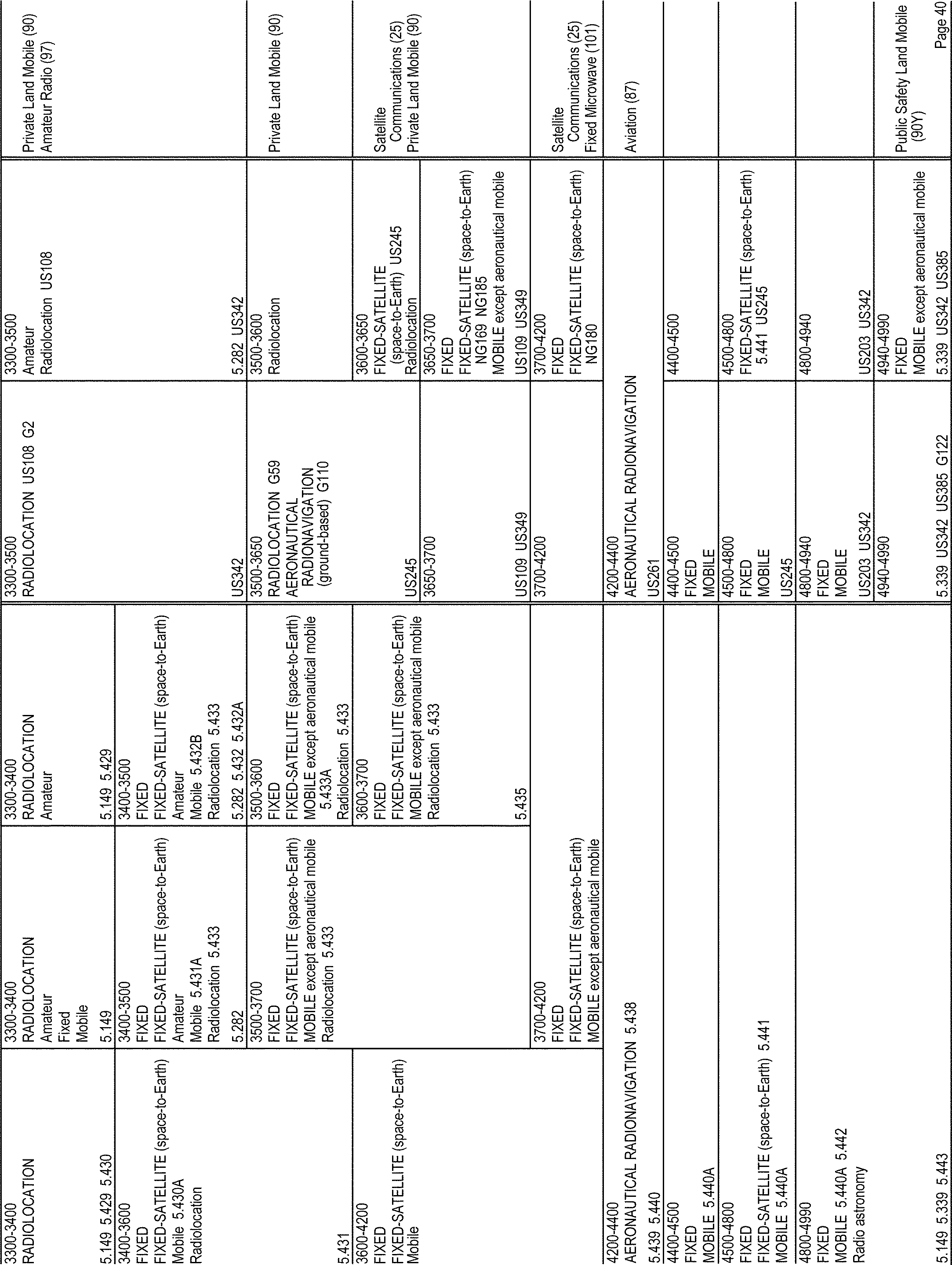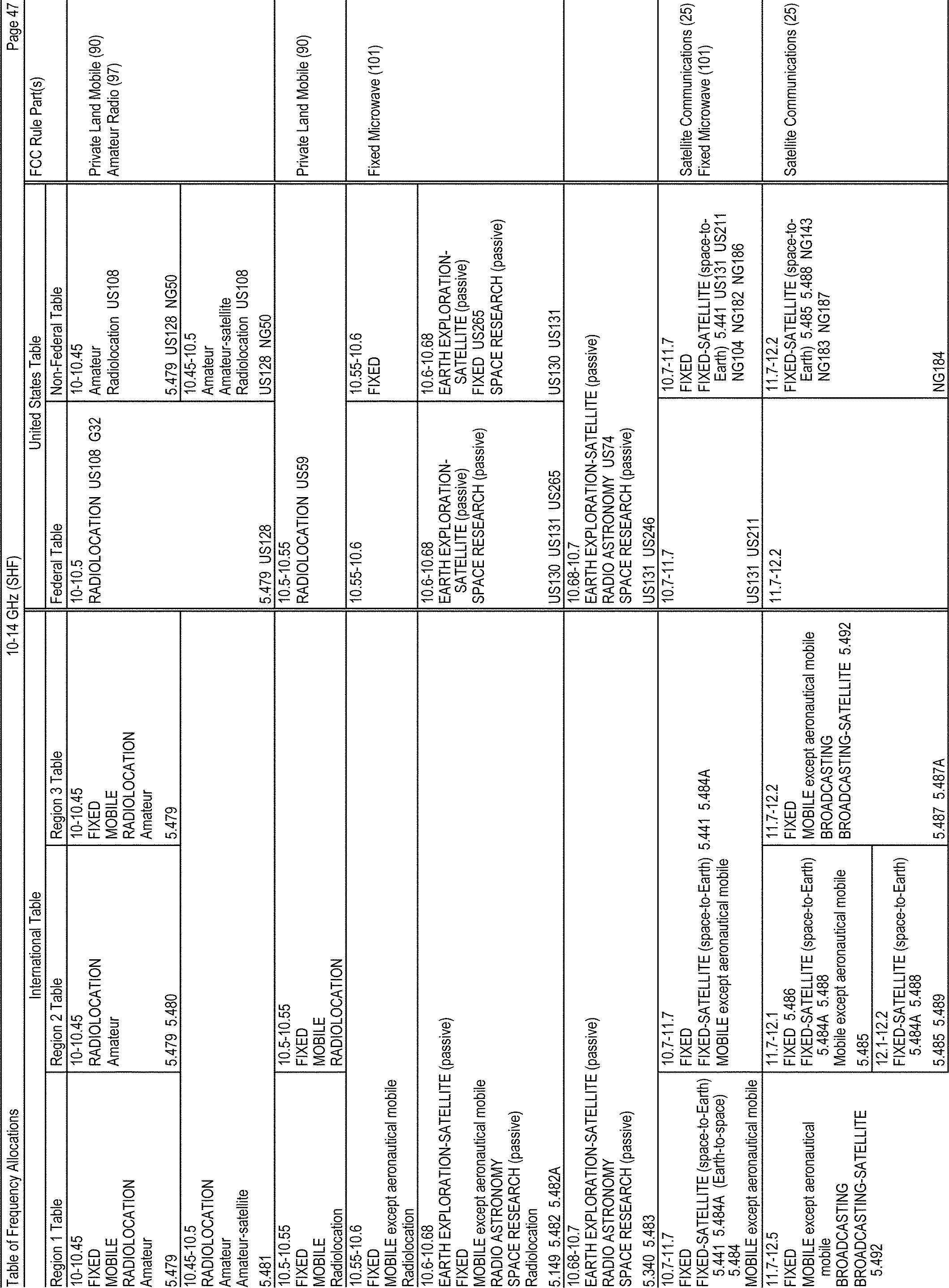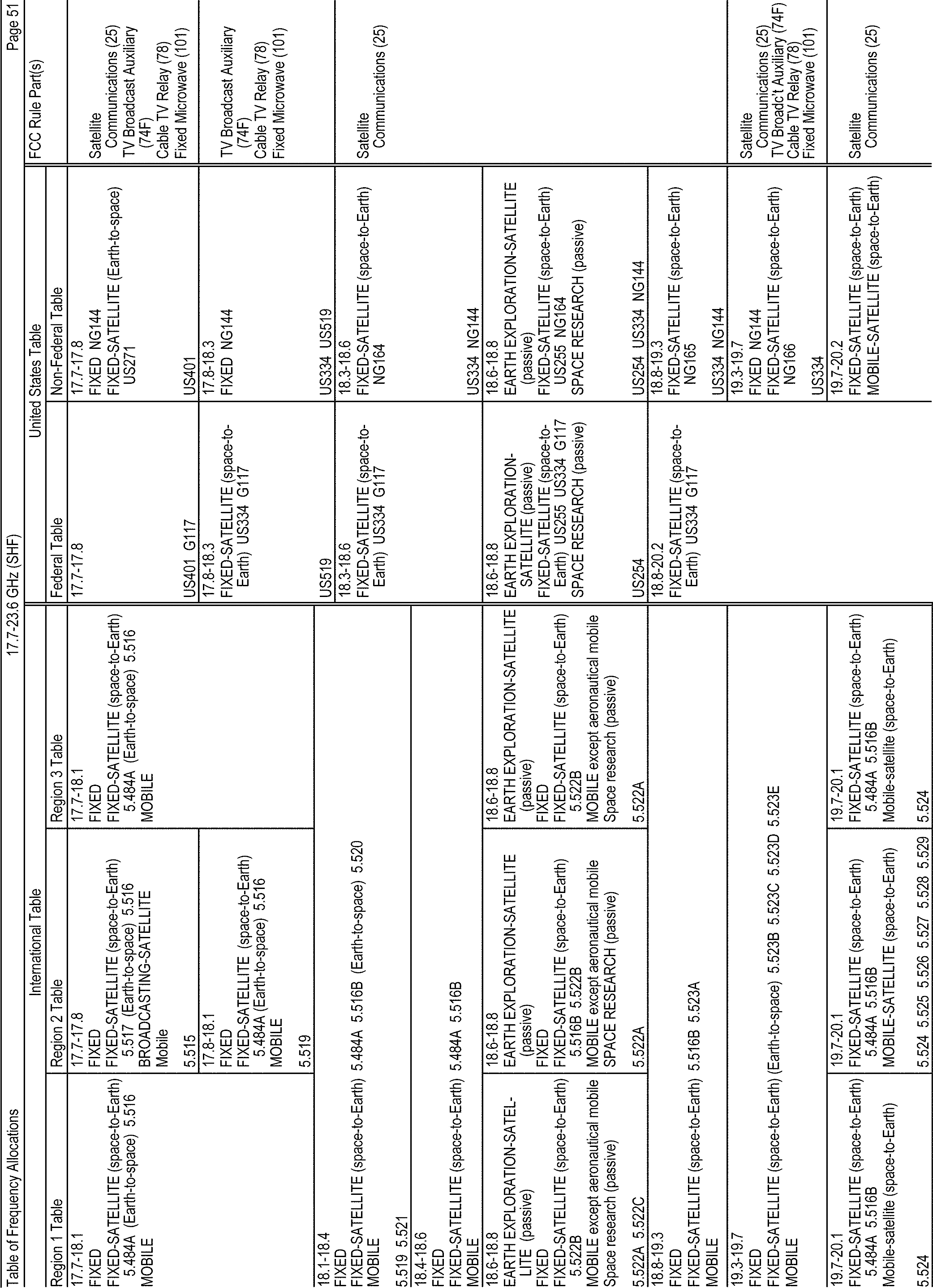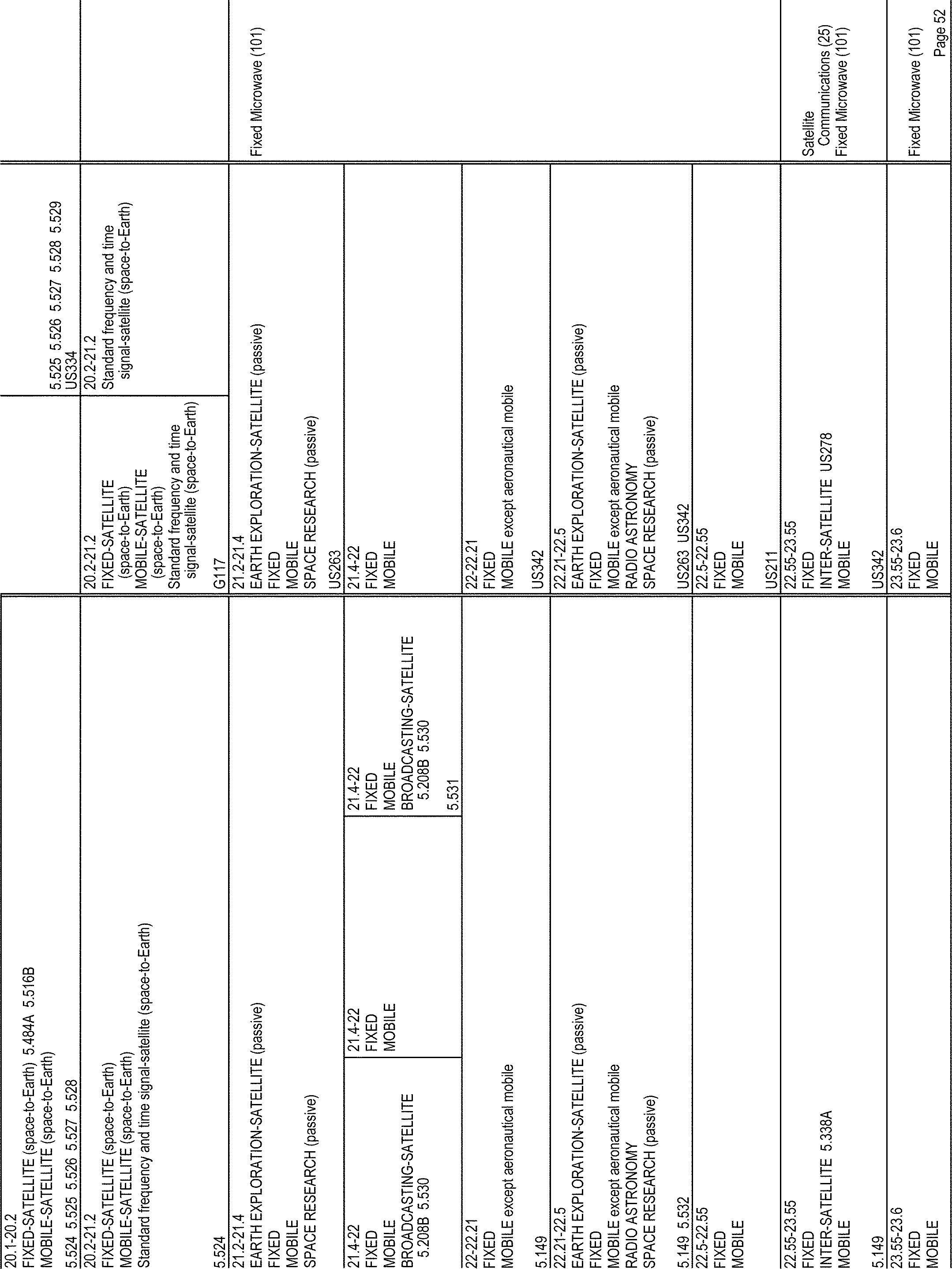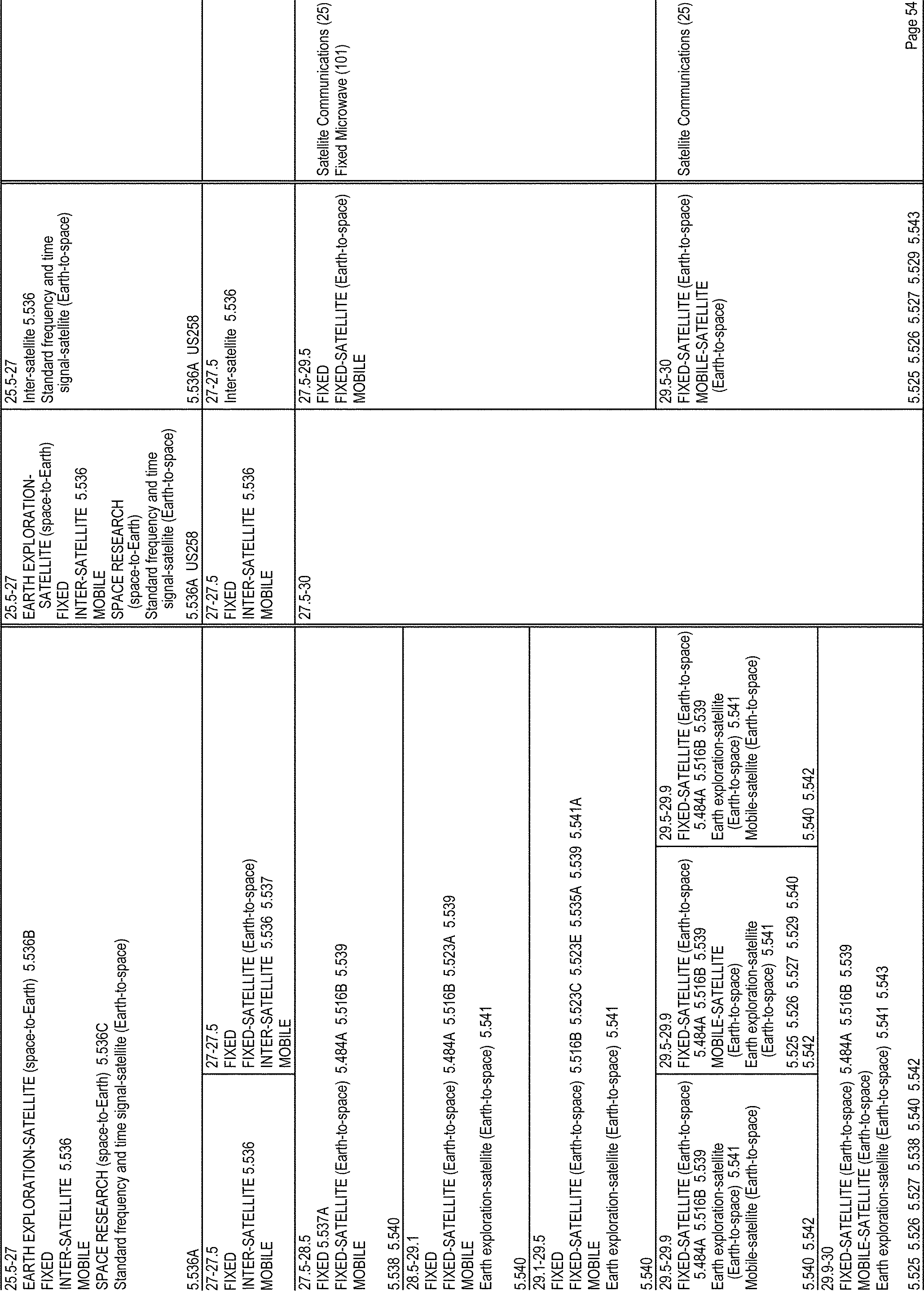-
Start Preamble
AGENCY:
Federal Communications Commission.
ACTION:
Final rule.
SUMMARY:
This document amends the Commission's rules to correct grammatical, typographical, and display errors in the United States Table of Frequency Allocations (U.S. Table) and also remove inconsistencies between the non-Federal Table of Frequency Allocations (non-Federal Table) and parts 15 and 90 of the Commission's rules.
DATES:
Effective January 28, 2013.
Start Further InfoFOR FURTHER INFORMATION CONTACT:
Tom Mooring, Office of Engineering and Technology, 202-418-2450, tom.mooring@fcc.gov.
End Further Info End Preamble Start Supplemental InformationSUPPLEMENTARY INFORMATION:
This is a summary of the Commission's Order, ET Docket No. 12-338, FCC 12-140, adopted November 15, 2012 and released November 19, 2012. The full text of this document is available for inspection and copying during normal business hours in the FCC Reference Center (Room CY-A257), 445 12th Street SW., Washington, DC 20554. The complete text of this document also may be purchased from the Commission's copy contractor, Best Copy and Printing, Inc., 445 12th Street SW., Room, CY-B402, Washington, DC 20554. The full text may also be downloaded at: www.fcc.gov. People with Disabilities: To request materials in accessible formats for people with disabilities (braille, large print, electronic files, audio format), send an email to fcc504@fcc.gov or call the Consumer & Governmental Affairs Bureau at 202-418-0530 (voice), 202-418-0432 (tty).
Summary of the Order
1. In the Order, the Commission makes several non-substantial editorial revisions to the parts 2, 15, and 90 of the Commission's rules. The most significant of these updates are: 1) correct the cross references to Allocation Table footnotes in parts 15 and 90 of the Commission's rules; 2) update the list of grandfathered sites in the 1432-1435 MHz band; and 3) remove an unused Federal site from the list of grandfathered sites in the 3650-3700 MHz band.
2. US117. NTIA requested that the Commission correct the coordinates for Table Mountain Observatory in US117 by revising the latitude from 40° 07′ 50” N to 40° 08′ 02” N. The Commission noted that the requested change would have little or no impact on non-Federal operations because paragraph (b) of US117 states that non-Federal use of the 406.1-410 MHz band is limited to the radio astronomy service and as provided by US13 (i.e., two channels that are available for the specific purpose of transmitting hydrological and meteorological data). Accordingly, the Commission revised the coordinates of the Table Mountain Observatory in US117 as requested by NTIA.
3. General Aviation Air-Ground Stations. Section 22.805 lists 13 channel pairs that are allocated for the provision of radiotelephone service to airborne mobile subscribers in general aviation aircraft. The Commission amended NG12 to accurately reflect the frequency bands that may be assigned to domestic public land and mobile stations to provide a two-way air-ground public radiotelephone service per Section 22.805. Accordingly, the Commission replaced the 454.4-455 MHz and 459.4-460 MHz bands in NG12 with the more specific 454.6625-454.9875 MHz and Start Printed Page 76235459.6625-459.9875 MHz bands, respectively. The Commission also takes this opportunity to renumber NG12 in frequency order as NG32.
4. Radiolocation Use of 420-450 MHz. The WRC-07 Table Clean-up Order renumbered US217 as US269, but did not update a cross reference to this footnote in § 90.103(c)(21). Accordingly, the Commission amended § 90.103 (“Radiolocation service”) by revising the cross reference in the last sentence of paragraph (c)(21) from “US217” to “US269.”
5. On-board Communications. In 2006, the Commission added § 80.373(g)(2) to its rules to make four frequencies (457.5375 MHz, 457.5625 MHz, 467.5375 MHz, and 467.5625 MHz) available for narrowband use by on-board ship communication stations within U.S. territorial waters. An international footnote, RR 5.287, provides for on-board communication stations on these frequencies outside the territorial waters of the United States. A separate footnote, RR 5.288, makes different frequencies available for on-board communication stations within the territorial waters of the United States. RR 5.288 is incomplete because it does not include the four narrowband frequencies listed in RR 5.287 that the Commission allocated in 2006 for use by on-board communication stations in the U.S. territorial waters. To correctly show the 2006 Commission action in the Allocation Table, the Commission replaced RR 5.288 with a new U.S. footnote, which we number as US288. US288 incorporates the text from RR 5.288 and adds the four frequencies contained in RR 5.287. The Commission also added a cross reference to part 80 (Stations in the Maritime Mobile Services) to the 462.7375-467.5375 MHz and 467.5375-467.7375 MHz bands in the Allocation Table.
6. US361. The 1432-1435 MHz band was a Government transfer band and US361 lists 23 operating areas where Federal stations in the fixed and mobile services may operate indefinitely on a primary basis. At NTIA's request, the Commission amended US361 by correcting the name of a grandfathered site and by removing a grandfathered site. Specifically, the Commission corrected the Location name for 37° 29′ North latitude, 114° 14′ West longitude from “Nellis AFB, NV” to “Nevada Test and Training Range (NTTR).” Next, because the “AUTEC” location is not within the United States and its insular areas (the listed coordinates are on Andros Island in The Bahamas), it removed this location from US361. Finally, the Commission reorganized and simplified the text of US361 and renumbered this U.S. footnote in frequency order as US83.
7. NG168. In the Mobile Use of MSS Bands R&O, the Commission revised the text of NG168. It further amended the text of NG168 to make the following grammatical corrections. First, the Commission introduced the MSS abbreviation, i.e., “mobile-satellite service (MSS)” in the first sentence and removed the introduction of the MSS abbreviation from the last sentence. Second, it made the word “component” plural in the first sentence. The Commission also took this opportunity to renumber NG168 in frequency order as NG43.
8. US385. The WRC-07 Table Clean-up Order added “the current text of US269, which urges fixed and mobile except aeronautical mobile licensees in the 2655-2690 MHz band to coordinate their systems, along with the secondary allocation status of the radio astronomy service in the 2655-2690 MHz band that is shown in the U.S. Table, to US311, and renumber[ed] US311 as US385.” However, the cross reference to US311 in § 15.242(e) was not updated at that time. Accordingly, the Commission amended the first sentence in paragraph (e) of § 15.242 by revising “US 311” to read “US385.”
9. US338. The text of US338 applies to the 2305-2310 MHz and 2310-2320 MHz bands, but the reference to US338 is shown only in the 2305-2310 MHz band. The Commission added the missing U.S. footnote, which it renumbered in frequency order as US97, to the 2310-2320 MHz band.
10. US348. Primary Federal operations in the 3650-3700 MHz band are limited to three grandfathered radar sites, which are codified in US348 and in § 90.1331(b)(1). NTIA has informed us that one of these sites—Naval Station Pascagoula—has been closed. Accordingly, the Commission amended US348 and § 90.1331(b)(1) to remove the unused Federal site. It also takes this opportunity to renumber US348 in frequency order as US109.
11. 10-10.5 GHz. With the concurrence of NTIA, the Commission amended the Federal Table by revising the “10-10.45” GHz band and the reference to “G2” to read “10-10.5” and “G32,” respectively. We also revise the text of three footnotes (US58, NG42, NG134) that pertain to the 10-10.5 GHz band. First, the Commission revised US58 by adding the existing amateur-satellite service allocation to the list of permitted non-Federal services in the 10-10.5 GHz band so that this footnote correctly lists all permitted non-Federal services, and it renumbered this footnote in frequency order as US128. Second, the Commission combined the text of NG42 and NG134 (which require that non-Federal stations in the radiolocation service not cause harmful interference to the amateur service in the 10-10.5 GHz band, and that these stations not cause harmful interference to the amateur-satellite service in the 10.45-10.5 GHz sub-band, respectively) and renumbered the new footnote in frequency order as NG50.
12. US277 and US355. Initially, NTIA requested that the Commission correct the coordinates for the Arecibo Observatory in US355 by approximately 68 meters (from 18° 20′ 39” N, 66° 45′ 10” W to 18° 20′ 37” N, 66° 45′ 11” W). Subsequently, NTIA requested that the Commission correct the elevations of nearly all of the radio astronomy observatories specified in US355. It noted that the requested changes are de minimis in nature and would affect only future non-geostationary satellite orbit systems in the fixed-satellite service (space-to-Earth). Accordingly, the Commission amended US355 by correcting the coordinates of the Arecibo Observatory and the elevations of 12 of the observatories. It also renumbered US355 in frequency order as US131 and added missing references to this footnote in the 10.6-10.68 GHz (Federal and non-Federal Tables) and 10.7-11.7 GHz bands (Federal Table). The Commission revised US277 by updating the cross reference from US355 to US131. Finally, the Commission renumbered US277 as US130, which places the allocation in US130 adjacent to the list of radio astronomy observatories in US131.
13. G27 and G117. At NTIA's request, the Commission amended the text of two Federal Government footnotes in § 2.106 of our rules. First, it amended G27 by revising “255” to read “225.” Second, the Commission amended G117 by replacing the “17.3-17.7 GHz” and “17.8-21.2 GHz” band entries with “17.375-17.475 GHz” and “17.6-21.2 GHz.” This action updates G117 by listing the sub-bands that are specified in US402 (17.375-17.475 GHz and 17.6-17.7 GHz) and by restricting Federal fixed-satellite service use of the 17.7-17.8 GHz band (which is authorized in US401) to military systems.
14. Allocation Display Changes. In the U.S. Table, the Commission generally does not subdivide a frequency band unless it is necessary to do so, e.g., when we are adding a radio service in only a segment of an existing frequency band. In the non-Federal Table, the only difference between the 19.7-20.1 GHz and 20.1-20.2 GHz bands is RR 5.529, and the only differences between the 29.5-29.9 GHz and 29.9-30 GHz bands Start Printed Page 76236are RR 5.529 and RR 5.543. Accordingly, the Commission merged these bands to form the 19.7-20.2 GHz and 29.5-30 GHz bands.
Paperwork Reduction Act
15. This Order contains no new or modified information collection requirements subject to the Paperwork Reduction Act of 1995 (PRA), Public Law 104-13. In addition, therefore, it does not contain any new or modified “information collection burden for small business concerns with fewer than 25 employees,” pursuant to the Small Business Paperwork Relief Act of 2002, Public Law 107-198, see 44 U.S.C. 3506(c)(4).
Congressional Review Act
16. The Commission will send a copy of this Order to Congress and the Government Accountability Office pursuant to the Congressional Review Act, see 5 U.S.C. 801(a)(1)(A).
Ordering Clauses
17. Pursuant to sections 1, 4, 301, 302(a), and 303 of the Communications Act of 1934, as amended, 47 U.S.C. sections 151, 154, 301, 302(a), and 303, and section 553(b)(B) of the Administrative Procedure Act, 5 U.S.C. 553(b)(B), this order is hereby adopted and the Commission's rules are amended as set forth in the Final rules.
18. The rule amendments adopted herein shall become effective January 28, 2013.
19. It is further ordered that the Commission shall send a copy of this Order in a report to be sent to Congress and the General Accounting Office pursuant to the Congressional Review Act, see 5 U.S.C. 801(a)(1)(A).
Start List of SubjectsList of Subjects in 47 CFR Parts 2, 15, and 90
- Spectrum
- International telecommunications
End SignatureFederal Communications Commission
Marlene H. Dortch,
Secretary.
Final Rules
For the reasons discussed in the preamble, the Federal Communications Commission amends 47 CFR parts 2, 15, and 90 as follows:
Start PartPART 2—FREQUENCY ALLOCATIONS AND RADIO TREATY MATTERS; GENERAL RULES AND REGULATIONS
End Part Start Amendment Part1. The authority citation for part 2 continues to read as follows:
End Amendment Part Start Amendment Part2. Section 2.106, the Table of Frequency Allocations, is amended to read as follows.
End Amendment Part Start Amendment Parta. Pages 27-28, 32, 36-37, 40, 47, 51-52, and 54 are revised.
End Amendment Part Start Amendment Partb. In the list of United States (US) Footnotes, footnotes US83, US97, US109, US128, US130, US131, and US288 are added; footnotes US58, US277, US338, US348, US355, and US361 are removed; and footnote US117 is revised.
End Amendment Part Start Amendment Partc. In the list of non-Federal Government (NG) Footnotes, footnotes NG32, NG43, and NG50 are added; and footnotes NG12, NG42, NG134, and NG168 are removed.
End Amendment Part Start Amendment Partd. In the list of Federal Government (G) Footnotes, footnotes G27 and G117 are revised.
End Amendment PartStart PartTable of Frequency Allocations.The revisions and additions read as follows:
* * * * *Start Printed Page 76237 Start Printed Page 76238 Start Printed Page 76239 Start Printed Page 76240 Start Printed Page 76241 Start Printed Page 76242 Start Printed Page 76243 Start Printed Page 76244 Start Printed Page 76245 Start Printed Page 76246 Start Printed Page 76247United States (US) footnotes
* * * * *US83 In the 1432-1435 MHz band, Federal stations in the fixed and mobile services may operate indefinitely on a primary basis at the 22 sites listed in the table below. The first 21 sites are in the United States and the last site is in Guam (GU). All other Federal stations in the fixed and mobile services shall operate in the band 1432-1435 MHz on a primary basis until re-accommodated in accordance with the National Defense Authorization Act of 1999.
State Site North West Radius AK Fort Greely 63°47′ 145°52′ 80 AL Redstone Arsenal 34°35′ 086°35′ 80 AZ Fort Huachuca 31°33′ 110°18′ 80 AZ Yuma Proving Ground 32°29′ 114°20′ 160 CA China Lake/Edwards AFB 35°29′ 117°16′ 100 CA Lemoore 36°20′ 119°57′ 120 FL Eglin AFB/Ft Rucker, AL 30°28′ 086°31′ 140 FL NAS Cecil Field 30°13′ 081°52′ 160 MD Patuxent River 38°17′ 076°24′ 70 ME Naval Space Operations Center 44°24′ 068°01′ 80 MI Alpene Range 44°23′ 083°20′ 80 MS Camp Shelby 31°20′ 089°18′ 80 NC MCAS Cherry Point 34°54′ 076°53′ 100 NM White Sands Missile Range/Holloman AFB 32°11′ 106°20′ 160 NV NAS Fallon 39°30′ 118°46′ 100 NV Nevada Test and Training Range (NTTR) 37°29′ 114°14′ 130 SC Beaufort MCAS 32°26′ 080°40′ 160 SC Savannah River 33°15′ 081°39′ 3 UT Utah Test and Training Range/Dugway Proving Ground, Hill AFB 40°57′ 113°05′ 160 VA NAS Oceana 36°49′ 076°01′ 100 WA NAS Whidbey Island 48°21′ 122°39′ 70 GU NCTAMS 13°35′ 144°51′ 80 Note: The coordinates (North latitude and West longitude) are listed under the headings North and West. The Guam entry under the West heading is actually 144°51′ East longitude. The operating radii in kilometers are listed under the heading Radius. * * * * *US97 The following provisions shall apply in the band 2305-2320 MHz:
(a) In the sub-band 2305-2310 MHz, space-to-Earth operations are prohibited.
(b) Within 145 km of Goldstone, CA (35°25′33″ N, 116°53′23″ W), Wireless Communications Service (WCS) licensees operating base stations in the band 2305-2320 MHz shall, prior to operation of those base stations, achieve a mutually satisfactory coordination agreement with the National Aeronautics and Space Administration (NASA).
Note:
NASA operates a deep space facility in Goldstone in the band 2290-2300 MHz.
* * * * *US109 The band 3650-3700 MHz is also allocated to the Federal radiolocation service on a primary basis at the following sites: St. Inigoes, MD (38°10′ N,76°23′ W) and Pensacola, FL (30°21′28″ N, 87°16′26″ W). The FCC shall coordinate all non-Federal operations within 80 km of these sites with NTIA on a case-by-case basis.
* * * * *US117 In the band 406.1-410 MHz, the following provisions shall apply:
(a) Stations in the fixed and mobile services are limited to a transmitter output power of 125 watts, and new authorizations for stations, other than mobile stations, are subject to prior coordination by the applicant in the following areas:
(1) Within Puerto Rico and the U.S. Virgin Islands, contact Spectrum Manager, Arecibo Observatory, HC3 Box 53995, Arecibo, PR 00612. Phone: 787-878-2612, Fax: 787-878-1861, Email: prcz@naic.edu.
(2) Within 350 km of the Very Large Array (34°04′44″ N, 107°37′06″ W), contact Spectrum Manager, National Radio Astronomy Observatory, P.O. Box O, 1003 Lopezville Road, Socorro, NM 87801. Phone: 505-835-7000, Fax: 505-835-7027, Email: nrao-rfi@nrao.edu.
(3) Within 10 km of the Table Mountain Observatory (40°08′02″ N, 105°14′40″ W) and for operations only within the sub-band 407-409 MHz, contact Radio Frequency Manager, Department of Commerce, 325 Broadway, Boulder, CO 80305. Phone: 303-497-4619, Fax: 303-497-6982, Email: frequencymanager@its.bldrdoc.gov.
(b) Non-Federal use is limited to the radio astronomy service and as provided by footnote US13.
* * * * *US128 In the band 10-10.5 GHz, pulsed emissions are prohibited, except for weather radars on board meteorological satellites in the sub-band 10-10.025 GHz. The amateur service, the amateur-satellite service, and the non-Federal radiolocation service, which shall not cause harmful interference to the Federal radiolocation service, are the only non-Federal services permitted in this band. The non-Federal radiolocation service is limited to survey operations as specified in footnote US108.
US130 The band 10.6-10.68 GHz is also allocated on a primary basis to the radio astronomy service. However, the radio astronomy service shall not receive protection from stations in the fixed service which are licensed to operate in the one hundred most populous urbanized areas as defined by the 1990 U.S. Census. For the list of observatories operating in this band, see footnote US131.
US131 In the band 10.7-11.7 GHz, non-geostationary satellite orbit licensees in the fixed-satellite service (space-to-Earth), prior to commencing operations, shall coordinate with the following radio astronomy observatories to achieve a mutually acceptable agreement regarding the protection of the radio telescope facilities operating in the band 10.6-10.7 GHz:Start Printed Page 76248
Observatory North latitude West longitude Elevation (in meters) Arecibo Observatory, PR 18°20′37″ 66°45′11″ 497 Green Bank Telescope (GBT), WV 38°25′59″ 79°50′23″ 807 Very Large Array (VLA), Socorro, NM 34°04′44″ 107°37′06″ 2,115 Very Long Baseline Array (VLBA) Stations: Brewster, WA 48°07′52″ 119°41′00″ 250 Fort Davis, TX 30°38′06″ 103°56′41″ 1,606 Hancock, NH 42°56′01″ 71°59′12″ 296 Kitt Peak, AZ 31°57′23″ 111°36′45″ 1,902 Los Alamos, NM 35°46′30″ 106°14′44″ 1,962 Mauna Kea, HI 19°48′05″ 155°27′20″ 3,763 North Liberty, IA 41°46′17″ 91°34′27″ 222 Owens Valley, CA 37°13′54″ 118°16′37″ 1,196 Pie Town, NM 34°18′04″ 108°07′09″ 2,365 St. Croix, VI 17°45′24″ 64°35′01″ 16 * * * * *US288 In the territorial waters of the United States, the preferred frequencies for use by on-board communication stations shall be 457.525 MHz, 457.550 MHz, 457.575 MHz and 457.600 MHz paired, respectively, with 467.750 MHz, 467.775 MHz, 467.800 MHz and 467.825 MHz. Where needed, equipment designed for 12.5 kHz channel spacing using also the additional frequencies 457.5375 MHz, 457.5625 MHz, 467.5375 MHz and 467.5625 MHz may be introduced for on-board communications. The characteristics of the equipment used shall conform to those specified in Recommendation ITU-R M.1174-2.
* * * * *Non-Federal Government (NG) Footnotes
* * * * *NG32 Frequencies in the bands 454.6625-454.9875 MHz and 459.6625-459.9875 MHz may be assigned to domestic public land and mobile stations to provide a two-way air-ground public radiotelephone service.
* * * * *NG43 Except as permitted below, the use of the band 2180-2200 MHz is limited to the mobile-satellite service (MSS) and ancillary terrestrial components offered in conjunction with an MSS network, subject to the Commission's rules for ancillary terrestrial components and subject to all applicable conditions and provisions of an MSS authorization. In the band 2180-2200 MHz, where the receipt date of the initial application for facilities in the fixed and mobile services was prior to January 16, 1992, said facilities shall operate on a primary basis and all later-applied-for facilities shall operate on a secondary basis to the MSS; and not later than December 9, 2013, all such facilities shall operate on a secondary basis.
* * * * *NG50 In the band 10-10.5 GHz, non-Federal stations in the radiolocation service shall not cause harmful interference to the amateur service; and in the sub-band 10.45-10.5 GHz, these stations shall not cause harmful interference to the amateur-satellite service.
* * * * *Federal Government (G) Footnotes
* * * * *G27 In the bands 225-328.6 MHz, 335.4-399.9 MHz, and 1350-1390 MHz, the fixed and mobile services are limited to the military systems.
* * * * *G117 In the bands 7.25-7.75 GHz, 7.9-8.4 GHz, 17.375-17.475 GHz, 17.6-21.2 GHz, 30-31 GHz, 33-36 GHz, 39.5-41 GHz, 43.5-45.5 GHz, and 50.4-51.4 GHz, the Federal fixed-satellite and mobile-satellite services are limited to military systems.
* * * * *PART 15—RADIO FREQUENCY DEVICES
End Part Start Amendment Part3. The authority citation for Part 15 continues to read as follows:
End Amendment Part Start Amendment Part4. Section 15.242 is amended by revising paragraph (e) to read as follows:
End Amendment PartStart PartOperation in the bands 174-216 MHz and 470-668 MHz.* * * * *(e) The user and the installer of a biomedical telemetry device operating within the frequency range 608-614 MHz and that will be located within 32 km of the very long baseline array (VLBA) stations or within 80 km of any of the other radio astronomy observatories noted in footnote US385 of Section 2.106 of this chapter must coordinate with, and obtain the written concurrence of, the director of the affected radio astronomy observatory before the equipment can be installed or operated. The National Science Foundation point of contact for coordination is: Spectrum Manager, Division of Astronomical Sciences, NSF Room 1045, 4201 Wilson Blvd., Arlington, VA 22230; tel: (703) 306-1823.
* * * * *PART 90—PRIVATE LAND MOBILE RADIO SERVICES
End Part Start Amendment Part5. The authority citation for Part 90 continues to read as follows:
End Amendment Part Start Amendment Part6. Section 90.103 is amended by revising the last sentence in paragraph (c)(21) to read as follows:
End Amendment PartStart Amendment PartRadiolocation Service.* * * * *(c) * * *
(21) * * * Authorizations will be granted on a case-by-case basis; however, operations proposed to be located within the zones set forth in footnote US269, § 2.106 of this chapter should not expect to be accommodated.
* * * * *7. Section 90.1331 is amended by revising paragraph (b)(1) to read as follows:
End Amendment PartEnd Supplemental InformationRestrictions on the operation of base and fixed stations.* * * * *(b)(1) Except as specified in paragraph (b)(2) of this section, base and fixed stations may not be located within 80 km of the following Federal Government radiolocation facilities:Start Printed Page 76249
St. Inigoes, MD—38°10′ N., 76°, 23′ W.
Pensacola, FL—30°21′28″ N., 87°, 16′ 26″ W.
Note to paragraph (b)(1):
Licensees installing equipment in the 3650-3700 MHz band should determine if there are any nearby Federal Government radar systems that could affect their operations. Information regarding the location and operational characteristics of the radar systems operating adjacent to this band are provided in NTIA TR-99-361.
* * * * *BILLING CODE 6712-01-P
BILLING CODE 6712-01-C
[FR Doc. 2012-31052 Filed 12-26-12; 8:45 am]
BILLING CODE 6712-01-P
Document Information
- Comments Received:
- 0 Comments
- Effective Date:
- 1/28/2013
- Published:
- 12/27/2012
- Department:
- Federal Communications Commission
- Entry Type:
- Rule
- Action:
- Final rule.
- Document Number:
- 2012-31052
- Dates:
- Effective January 28, 2013.
- Pages:
- 76234-76249 (16 pages)
- Docket Numbers:
- ET Docket No. 12-338, FCC 12-140
- PDF File:
- 2012-31052.pdf
- CFR: (4)
- 47 CFR 2.106
- 47 CFR 15.242
- 47 CFR 90.103
- 47 CFR 90.1331
